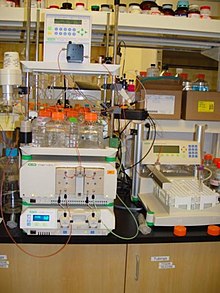Size exclusion chromatography

Equipment for running size-exclusion chromatography. The buffer is pumped through the column (right) by a computer-controlled device
|
|
| Acronym | SEC |
|---|---|
| Classification | Chromatography |
| Analytes |
macromolecules synthetic polymers biomolecules |
| Manufacturers | Knauer |
| Other techniques | |
| Related |
High performance liquid chromatography Aqueous Normal Phase Chromatography Ion exchange chromatography Micellar liquid chromatography |
Size-exclusion chromatography (SEC), also known as molecular sieve chromatography, is a chromatographic method in which molecules in solution are separated by their size, and in some cases molecular weight. It is usually applied to large molecules or macromolecular complexes such as proteins and industrial polymers. Typically, when an aqueous solution is used to transport the sample through the column, the technique is known as gel-filtration chromatography, versus the name gel permeation chromatography, which is used when an organic solvent is used as a mobile phase. SEC is a widely used polymer characterization method because of its ability to provide good molar mass distribution (Mw) results for polymers.
The main application of gel-filtration chromatography is the fractionation of proteins and other water-soluble polymers, while gel permeation chromatography is used to analyze the molecular weight distribution of organic-soluble polymers. Either technique should not be confused with gel electrophoresis, where an electric field is used to "pull" or "push" molecules through the gel depending on their electrical charges.
The advantages of this method include good separation of large molecules from the small molecules with a minimal volume of eluate, and that various solutions can be applied without interfering with the filtration process, all while preserving the biological activity of the particles to be separated. The technique is generally combined with others that further separate molecules by other characteristics, such as acidity, basicity, charge, and affinity for certain compounds. With size exclusion chromatography, there are short and well-defined separation times and narrow bands, which lead to good sensitivity. There is also no sample loss because solutes do not interact with the stationary phase.
The other advantage to this experimental method is that in certain cases it is feasible to determine the approximate molecular weight of a compound. The shape and size of the compound (eluent) determine how the compound interacts with the gel (stationary phase). In order to determine the approximate molecular weight, the elution volumes of compounds with their corresponding molecular weights are obtained and then a plot of “Kav” vs “log(Mw)” is made, where Kav = (Ve-Vo)/(Vt-Vo) and Mw is the molecular mass. This plot acts as a calibration curve, which is used to approximate the desired compound’s molecular weight. The Ve component represents the volume at which the intermediate molecules elute such as molecules that have partial access to the beads of the column. In addition, Vt is the sum of the total volume between the beads and the volume within the beads. The Vo component represents the volume at which the larger molecules elute, which elute in the beginning. Disadvantages are, for example, that only a limited number of bands can be accommodated because the time scale of the chromatogram is short, and, in general, there has to be a 10% difference in molecular mass to have a good resolution
...
Wikipedia
